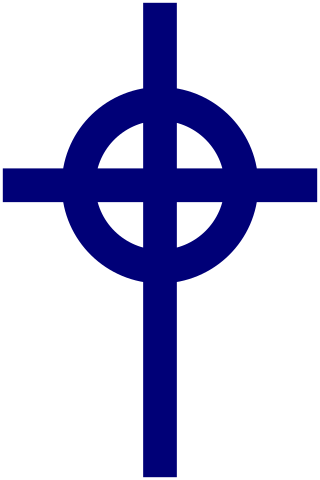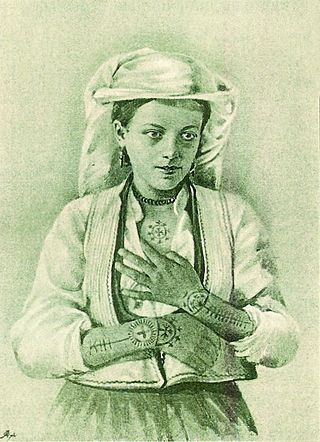
A cross is a compound geometrical figure consisting of two intersecting lines, usually perpendicular to each other. The lines usually run vertically and horizontally. A cross of oblique lines, in the shape of the Latin letter X, is termed a saltire in heraldic terminology.

The labarum was a vexillum that displayed the "Chi-Rho" symbol ☧, a christogram formed from the first two Greek letters of the word "Christ" – Chi (χ) and Rho (ρ). It was first used by the Roman emperor Constantine the Great.

The swastika is a symbol predominantly used in various Eurasian religions and cultures, as well in some African and American ones. In the Western world, it is more widely recognized as a symbol of the German Nazi Party who appropriated it from Asian cultures starting in the early 20th century. The appropriation continues with its use by neo-Nazis around the world. The swastika was and continues to be used as a symbol of divinity and spirituality in Indian religions, including Hinduism, Buddhism, and Jainism. It generally takes the form of a cross, the arms of which are of equal length and perpendicular to the adjacent arms, each bent midway at a right angle.

In geometry, two geometric objects are perpendicular if their intersection forms right angles at the point of intersection called a foot. The condition of perpendicularity may be represented graphically using the perpendicular symbol, ⟂. Perpendicular intersections can happen between two lines, between a line and a plane, and between two planes.
The fylfot or fylfot cross and its mirror image, the gammadion, are types of swastika associated with medieval Anglo-Saxon culture. It is a cross with perpendicular extensions, usually at 90° or close angles, radiating in the same direction. However – at least in modern heraldry texts, such as Friar and Woodcock & Robinson – the fylfot differs somewhat from the archetypal form of the swastika: always upright and typically with truncated limbs, as shown in the figure at right.

The Celtic cross is a form of Christian cross featuring a nimbus or ring that emerged in Ireland, France and Great Britain in the Early Middle Ages. A type of ringed cross, it became widespread through its use in the stone high crosses erected across the islands, especially in regions evangelised by Irish missionaries, from the ninth through the 12th centuries.

Brigid's cross or Brigit's cross is a small variant of the Christian cross often woven from straw or rushes. It appears in many different shapes; the earliest designs were simple Christian Latin or Greek crosses, but the most popular modern iteration features a woven diamond or lozenge in the centre. The cross is named for the Christian saint Brigid of Kildare.

A solar symbol is a symbol representing the Sun. Common solar symbols include circles, crosses, and spirals. In religious iconography, personifications of the Sun or solar attributes are often indicated by means of a halo or a radiate crown.
In geometry, parallel lines are coplanar infinite straight lines that do not intersect at any point. Parallel planes are planes in the same three-dimensional space that never meet. Parallel curves are curves that do not touch each other or intersect and keep a fixed minimum distance. In three-dimensional Euclidean space, a line and a plane that do not share a point are also said to be parallel. However, two noncoplanar lines are called skew lines. Line segments and Euclidean vectors are parallel if they have the same direction or opposite direction.

Fascist symbolism is the use of certain images and symbols which are designed to represent aspects of fascism. These include national symbols of historical importance, goals, and political policies. The best-known are the fasces, which was the original symbol of fascism, and the swastika of Nazism.

A Christogram is a monogram or combination of letters that forms an abbreviation for the name of Jesus Christ, traditionally used as a religious symbol within the Christian Church.

The tradition of egg decoration in Slavic cultures originated in pagan times, and was transformed by the process of religious syncretism into the Christian Easter egg. Over time, many new techniques were added. Some versions of these decorated eggs have retained their pagan symbolism, while others have added Christian symbols and motifs.

In geometry, a transversal is a line that passes through two lines in the same plane at two distinct points. Transversals play a role in establishing whether two or more other lines in the Euclidean plane are parallel. The intersections of a transversal with two lines create various types of pairs of angles: consecutive interior angles, consecutive exterior angles, corresponding angles, and alternate angles. As a consequence of Euclid's parallel postulate, if the two lines are parallel, consecutive interior angles are supplementary, corresponding angles are equal, and alternate angles are equal.
A religious image is a work of visual art that is representational and has a religious purpose, subject or connection. All major historical religions have made some use of religious images, although their use is strictly controlled and often controversial in many religions, especially Abrahamic ones. General terms associated with religious images include cult image, a term for images, especially in sculpture which are or have been claimed to be the object of religious worship in their own right, and icon strictly a term for Eastern Orthodox religious images, but often used more widely, in and outside the area of religion.

Sicanje or bocanje was a widespread custom mostly among Roman Catholic Croat teenage girls and boys of the central regions of Bosnia and Herzegovina, as well as the Dalmatia region of Croatia. The practice, which has been widespread among Albanians and also Vlach women, native populations of the western Balkans, predates the Slavic migration to the Balkans, and consequently Christianity itself, tracing back to Illyrian times, but scholars documented it in the 19th century.

The swastika design is known from artefacts of various cultures since the Neolithic, and it recurs with some frequency on artefacts dated to the Germanic Iron Age, i.e. the Migration period to Viking Age period in Scandinavia, including the Vendel era in Sweden, attested from as early as the 3rd century in Elder Futhark inscriptions and as late as the 9th century on Viking Age image stones.

Enji is the name of the fire god in the Albanian pagan mythology evidently contained in the week day name that was dedicated to him – e enjte – the Albanian word for Thursday. The Fire – Zjarri – is deified in Albanian tradition, with the power to ward off [[evil and darkness, give strength to the Sun, sustain the continuity between life and afterlife and between the generations. The divine power of Fire is used for the hearth and the rituals, including calendar fires, sacrificial offerings, divination, purification, and protection from big storms and other potentially harmful events. Fire worship and rituals are associated with the cult of the Sun (Dielli), the cult of the hearth (vatër) and the ancestor, and the cult of fertility in agriculture and animal husbandry. Fire rituals that are commonly found among Indo-European peoples, including the Albanians, have been firstly attested by the Vedas, with hymns dedicated to the fire god Agni. Described in written sources since 1482, the Albanian practices associated with ritual fires have been historically fought by the Christian clergy, without success. The cult of the mystic fire and the fire ritual practices have played a prominent role in the lives of all the Albanian people until the 20th century, and in rural areas they continue to be important for Albanian traditional customs even in the present days.

Over the millennia of its development, Hinduism has adopted several iconic symbols, forming part of Hindu iconography, that are imbued with spiritual meaning based on either the scriptures or cultural traditions. The exact significance accorded to any of the icons varies with region, period and denomination of the followers. Over time some of the symbols, for instance the Swastika has come to have wider association while others like Om are recognized as unique representations of Hinduism. Other aspects of Hindu iconography are covered by the terms murti, for icons and mudra for gestures and positions of the hands and body.

Tattooing among Albanians is a long-standing tradition that has been practiced since Illyrian times, kept alive in the mountainous areas of the western Balkans. Traditional tattooing has also been practiced by Catholics in Bosnia and Herzegovina and Dalmatia (Sicanje), and by women of some Vlach communities.

Hëna, the Moon, holds a prominent position in Albanian pagan customs, beliefs, rituals, myths, and legends. In Albanian traditions the Moon's cyclical phases have regulated many aspects of life, defining agricultural and livestock activities, various crafts, and human body.

















